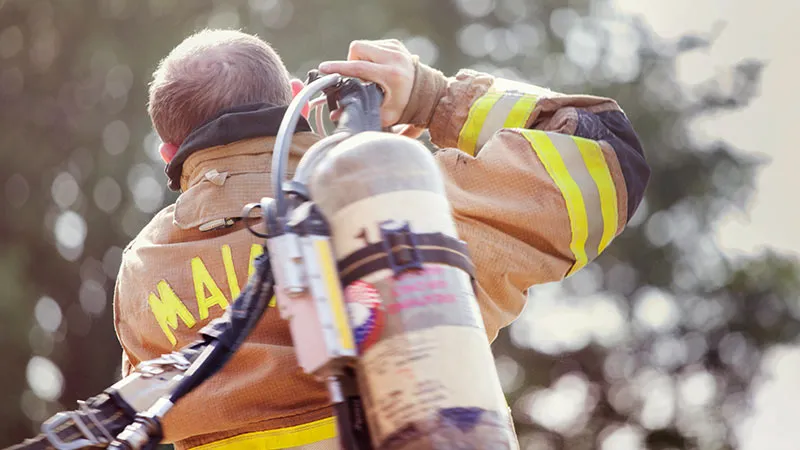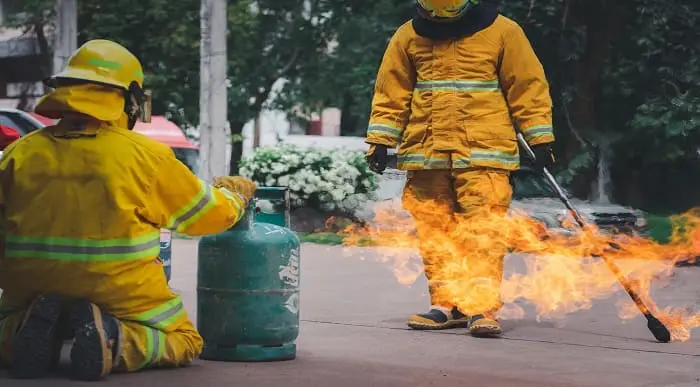Health and Safety
How Do Water Fire Extinguishers Work – Types, Color & Use
According to Explain that Stuff, One of humanity’s earliest discoveries, fire is also one of the greatest hazards. A fire can destroy a home or business that has taken decades to build in minutes. That is why firefighting techniques are so important as it plays a vital role in controlling small fires in an emergency moment.
Here, the purpose of a fire extinguisher is to cool it down. Solids, including wood, paper, textiles and other fire threats, are extinguished with water extinguishers. Water is a good medium for electricity, but there is a risk of electrocution if we use it to put out an electrical fire. Hence, before using a water extinguisher on electrical equipment, it must be unplugged.
To discover about different types of fire extinguishers, how do water fire extinguishers work and some other essential aspects, give this blog a read.
Check out our other blog, “What is a Dynamic Risk Assessment? [Complete Guide].”
Table of Content
What are Fire Extinguishers?
We can define fire extinguishers as portable or movable apparatus used to put out a small fire by directing onto it substances used for extenuating fire. This cools the burning material, deprives the flame of oxygen, or interferes with the chemical reactions occurring in the flame.
Fire extinguishers work and protect our property. It plays a vital role in minimising the fire. The main task of fire extinguishers is to cut off the flow or decrease the temperature of the fuel.
Before we start with the different types of fire extinguishers and find out the type of fire, they put out, knowing the classes of fire becomes essential.
Classes of Fire
Depending upon the burning material, here are five classes of fire. However, some quarters count the 6th (Class E – Electrical fires)-
A Fires – Involves solid materials such as wood, paper or textiles.
B Fires – Involves flammable liquids such as petrol, diesel or oils.
C Fires – Involves gases.
D Fires – Involves metals.
E Fires – Involves live electrical apparatus. (Though ‘Class E’ doesn’t exist, we are using it here for our convenience)
F Fires (Class K Fires) – Involves cooking oils such as in deep-fat fryers.
 Are you looking for a Fire Extinguishers Training Online Course?
Are you looking for a Fire Extinguishers Training Online Course?
Different Types of Fire Extinguishers
According to Marsden Fire Safety, there are six types of fire extinguishers.
Water Extinguishers
Water extinguishers are one of the most cost-effective products to put out Class A fires. They come in four varieties: water jet, water spray, water with additives, and water mist or fog.
Foam extinguishers
On Class A and B fires, foam fire extinguishers can be used. They’re best for putting out liquid fires like gasoline or diesel, but they’re more versatile than water jet extinguishers because they can also put out solid fires like wood and paper. Liquid fires are extinguished by foam by sealing the liquid’s surface from reaching the air and starving the fire of fuel.
Besides, check out our other blog, “How Many Steps are There to a Risk Assessment?”
Powder extinguishers
To put out Class A, B, and C flames, a powder extinguisher is used, making it a versatile fire extinguisher. Powder extinguishers can also be used to put out flames caused by electrical equipment, but they do not cool the fire down enough for it to re-ignite.
Powder extinguishers can also reduce visibility and increase breathing difficulties. So, unless there is no other choice, these extinguishers are not suggested for usage inside buildings.
Carbonic acid gas (CO2)
CO2 extinguishers are more suitable for settings with several electrical tools, such as offices or server rooms when they are activated on fires involving electrical apparatus. Such extinguishers do not leave any residue, unlike other extinguishers such as foam extinguishers.
CO2 extinguishers are used to put out Class B fires by suffocating the burning material and cutting off their oxygen supply.
Wet chemical extinguishers
Olive oil, sunflower oil, maise oil, butter and Class F fires can be put out with wet chemical extinguishers. The soggy or wet chemical quickly extinguishes the flames, cools the burning oil, and reacts chemically to generate a soap-like solution that seals the surface and prevents re-ignition.
Wet chemical extinguishers can also be used on Class A and Class B flames, such as wood, paper, and fabrics.

Fire Marshal Course for Care Homes
- Accredited Courses
- Tutor Support Included
- 3 Installment Plan at checkout
- 14 Days Money Back Guarantee
Generally, hot oil fires, which can be found in frying pans or tiny deep fat fryers, are the main focus of fire blankets. It creates a great advantage for different types of accidents which happen because of fire.
For example, it can be used to put out a fire in someone’s clothing. They function by suffocating the flames, cutting off the oxygen supply, and extinguishing it.
Fire Extinguisher Colour Code
There are various colours for different types of extinguishers. Let’s analyse what these colours represent for each extinguisher.
| A: Green | You should use green extinguishers for paper, cloth and wood. |
| B: Red | Red extinguishers are used for explosive and burnable liquids such as oil, gasoline, and paint. |
| C: Blue | Blue extinguishers are normally used for electrical equipment tools. |
| D: Orange | Orange extinguishers are used for burnable metals. |
| E: Black | Black extinguishers are used for animal or vegetable oils or cooking fats. |
Use of Fire Extinguishers
According to Safe Fire Direct, “one of the most suitable and cost-effective solutions to put out Class A fires involving paper, wood, and textiles.”
A little spark might ignite the entire area in places where you would use a lots of paper or wood. Therefore, it is essential to have water fire extinguishers for offices, workshops, homes, caravans, and flats. A fire extinguisher is tiny and easily kept beneath a seat or in the boot.
The 3 Ltr Water with Additive is an excellent addition to your automobile.
By exploring onlinesafetydepot.com we found some differences between water fire extinguishers and other types of fire extinguishers in their design.
You should outline fire extinguishers to cool or extinguish a fire by releasing water. Then you remove the safety pin when you break the tamper seal, squeeze the lever, and forcibly downward a pointed rod within the valve assembly.
Steps
- The water is forced downward as the gas is released into the cylindrical tank.
- You then pump the water through a tube that goes up the inside of the fire extinguisher tank to the valve assembly and out the hose under pressure.
- The gas pressure propels the water from the fire extinguisher far enough to put out the flames from a safe distance of 4-6 feet.
- We know that the primary chemical reaction that causes fire is (Oxygen + Heat + Fuel = Fire Process. Every fire categorization, however, has its own distinct characteristics and fuel supply.
- This necessitates the use of a fire extinguisher designed to put out a specific type of fire. You should use water extinguishers to put out Class A fires (combustibles like wood, paper, cloth, garbage, and plastics) by reducing the heat component of the fire.
- The chemical reaction for fire is no longer viable when you will remove the heat and quench the fire.
According to US Fire Administration, it is important to tell the residents to remember the phrase PASS, when using a fire extinguisher. Secondly, you should remove the pin and lock the mechanism to release it while holding the extinguisher with the nozzle facing away from you. Then you have to lower your sights and place the extinguisher near the fire’s origin. Then you should squeeze the lever slowly and evenly and sweep back and forth the nozzle.
Top Courses of this Category
How Do Water Fire Extinguishers Work?
Water fire extinguishers mainly work by cooling down the temperature of the fire. By exploring checkfire.co.uk we find that water fire can be used to minimise the power of fire, as it will make it difficult for the fire to burn and eventually extinguish the flames. Generally, boiling water is inside a water fire extinguisher, as boiling water can put out the fire quickly.
Water fire extinguishers have a spray nozzle rather than a jet nozzle, allowing the water to cover a considerably larger surface area and ultimately putting out the fire quickly.
According to Fire Protection Online, by lowering the surface tension on the water, the fire extinguishers make the overall place wetter, which puts out the fire. You can add additional chemicals, such as soaping agents, to the mix, enhancing the extinguisher’s efficiency.
Pros and Cons of Water Extinguishers
| Pros | Cons |
| According to the Fire Risk Assessment Network, water fire extinguishers does not have any negative effects on the environment. | They only work on Class A fire. |
| Water fire extinguishers are extremely cooling and work quickly. | These can be harmful if the water comes close to the electronics equipment. |
Conclusion
Though there are different types of fire extinguishers available in the market, to save our surroundings from some of the most common types of fire or burning accidents, thus you can use water fire extinguishers. I hope this blog has helped you resolve all your water fire extinguisher-related concerns.
FAQs
How does a water fire extinguisher work?
Water fire extinguishers work by spreading the water stream at the fire, which blows out the flames and burning staff.
What type of water is in a water fire extinguisher?
Generally, boiling water is inside a water fire extinguisher, as boiling water can put out the fire quickly.
How to identify a water fire extinguisher?
To identify water fire extinguishers, we can analyse the colour. For example, the most commonly used water fire extinguisher is the red label which is popular for class A fires.
Who needs water fire extinguishers?
Typically homes and all types of organisations need water fire extinguishers. Such as banks, hospitals etc.
How to use a water fire extinguisher?
Firstly, the user needs to pull the pin while grabbing the water fire extinguisher. Secondly, the user needs to focus and aim the water fire extinguisher towards the fire. Thirdly, the user needs to press the handle. Lastly, the user needs to sweep or move from side to side.
Do not use water fire extinguishers for?
Water fire extinguishers are not appropriate for use on burnable metal. It is especially not appropriate for an electrical fire.
What to Read Next:
- How to Become a Health and Safety Officer
- How Many Common Types of Asbestos Are There
- How Often Do Day Staff Require Fire Training?
- How to Become a Firefighter – Step by Step Guide













